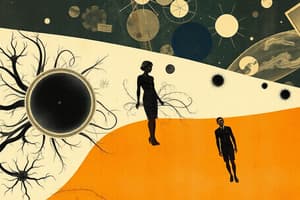Podcast
Questions and Answers
What are Primordial Germ Cells (PGCs) derived from during embryonic development?
What are Primordial Germ Cells (PGCs) derived from during embryonic development?
- Epiblast cells (correct)
- Ectoderm cells
- Mesoderm cells
- Endoderm cells
At what week do Primordial Germ Cells migrate towards the developing gonads?
At what week do Primordial Germ Cells migrate towards the developing gonads?
- 5th week (correct)
- 3rd week
- 4th week
- 6th week
What does the Chromosome Theory of Inheritance state regarding traits?
What does the Chromosome Theory of Inheritance state regarding traits?
- Traits have no genetic basis and are randomly assigned.
- Traits are only influenced by environmental factors.
- Traits are an expression of epigenetic changes.
- Traits are determined by specific genes on chromosomes inherited from parents. (correct)
What are teratomas believed to arise from?
What are teratomas believed to arise from?
Which of the following tissues is NOT typically found in teratomas?
Which of the following tissues is NOT typically found in teratomas?
Which germ layer is NOT formed by the epiblast?
Which germ layer is NOT formed by the epiblast?
What role do epiblast cells play during gastrulation?
What role do epiblast cells play during gastrulation?
What is the primary function of gametogenesis?
What is the primary function of gametogenesis?
What does the Wolffian duct differentiate into?
What does the Wolffian duct differentiate into?
What is the role of Müllerian inhibiting hormone?
What is the role of Müllerian inhibiting hormone?
What is the outcome of mitosis?
What is the outcome of mitosis?
How many divisions occur during meiosis?
How many divisions occur during meiosis?
At the end of meiosis I in humans, how many unique chromosomes does each daughter cell have?
At the end of meiosis I in humans, how many unique chromosomes does each daughter cell have?
What is synapsis in meiosis?
What is synapsis in meiosis?
What occurs during crossing-over in meiosis?
What occurs during crossing-over in meiosis?
What type of cells does meiosis produce?
What type of cells does meiosis produce?
How many total genes do humans have across their chromosomes?
How many total genes do humans have across their chromosomes?
What is the primary function of the SRY gene?
What is the primary function of the SRY gene?
Which of the following statements is true regarding sex chromosomes in humans?
Which of the following statements is true regarding sex chromosomes in humans?
Linked genes are inherited together because they are located on which of the following?
Linked genes are inherited together because they are located on which of the following?
What does the testis-determining factor (TDF) do?
What does the testis-determining factor (TDF) do?
How many autosomes do humans have in their chromosomes?
How many autosomes do humans have in their chromosomes?
What is the relationship between genes on the same chromosome?
What is the relationship between genes on the same chromosome?
Which organ is transformed into a testis by the action of the SRY gene?
Which organ is transformed into a testis by the action of the SRY gene?
Flashcards are hidden until you start studying
Study Notes
Gametogenesis Overview
- Gametogenesis involves the transformation of germ cells into haploid gametes.
- Gametes originate from primordial germ cells (PGCs), which are formed during the second week of embryonic development.
Primordial Germ Cells
- PGCs arise from the epiblast and migrate to gonads by the fifth week of development.
- Evidence suggests that teratomas may develop from PGCs that stray from their designated migratory path.
- Teratomas are tumors containing mixed tissues, such as muscle, bone, and hair, indicating pluripotent stem cell derivation.
Chromosome Theory of Inheritance
- Traits in offspring are determined by genes located on chromosomes inherited from both parents.
- Humans possess approximately 23,000 genes spread across 46 chromosomes, with 22 pairs identified as autosomes.
- The sex chromosomes determine gender and are ultimately linked with inherited traits.
Sex Determination Mechanism
- The SRY gene on the Y chromosome dictates primary sex determination by coding for testis-determining factor (TDF).
- TDF action results in the differentiation of bipotential gonads into testes.
Structuring of Reproductive Organs
- Wolffian ducts develop male genital tract structures while Müllerian ducts form the basis of female reproductive organs.
- Müllerian inhibiting hormone promotes the regression of Müllerian ducts in males.
Cell Division Processes
- Mitosis produces two identical daughter cells with a complete set of 46 chromosomes.
- During S Phase, prior to mitosis, DNA replication occurs to ensure each daughter cell receives a full chromosomal complement.
Meiosis Overview
- Meiosis is a specialized cell division that results in gametes, reducing chromosome number to haploid (half) through two divisions.
- Each daughter cell at the conclusion of meiosis I contains 23 distinct chromosomes.
Key Processes in Meiosis
- Crossing-over during meiosis allows genetic material exchange, increasing genetic diversity at the chiasmata.
- In humans, the unique haploid chromosome set results from the recombination and independent assortment of chromosomes during meiosis.
Studying That Suits You
Use AI to generate personalized quizzes and flashcards to suit your learning preferences.



